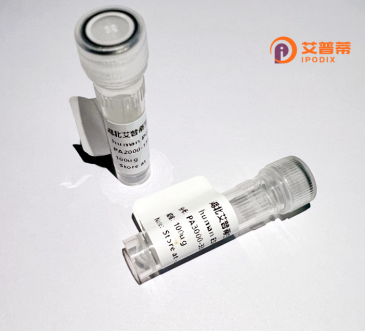
| 纯度 | >90%SDS-PAGE. |
| 种属 | Human |
| 靶点 | CLCN2 |
| Uniprot No | P51788 |
| 内毒素 | < 0.01EU/μg |
| 表达宿主 | E.coli |
| 表达区间 | 38-387aa |
| 氨基酸序列 | TVSTAVIVFELTGQIAHILPVMIVVILANAVAQSLQPSLYDSIIRIKKLPYLPELGWGRHQQYRVRVEDIMVRDVPHVALSCTFRDLRLALHRTKGRMLALVESPESMILLGSIERSQVVALLGAQLSPARRRQHMQERRATQTSPLSDQEGPPTPEASVCFQVNTEDSAFPAARGETHKPLKPALKRGPSVTRNLGESPTGSAESAGIALRSLFCGSPPPEAASEKLESCEKRKLKRVRISLASDADLEGEMSPEETHTIFSLLGVDHAYVTSIGRLIGIVTLKELRKAIEGSVTAQGVKVRPPLASFRDSATSSSDTETTEVHALWGPHSRHGLPREGSPSDSDDKCQ |
| 分子量 | 64.24 kDa |
| 蛋白标签 | GST-tag at N-terminal |
| 缓冲液 | 0 |
| 稳定性 & 储存条件 | Lyophilized protein should be stored at ≤ -20°C, stable for one year after receipt. Reconstituted protein solution can be stored at 2-8°C for 2-7 days. Aliquots of reconstituted samples are stable at ≤ -20°C for 3 months. |
| 复溶 | Always centrifuge tubes before opening.Do not mix by vortex or pipetting. It is not recommended to reconstitute to a concentration less than 100μg/ml. Dissolve the lyophilized protein in distilled water. Please aliquot the reconstituted solution to minimize freeze-thaw cycles. |
1. **"Functional characterization of recombinant human CLCN2 chloride channels"** - Smith et al.
该研究通过异源表达系统(如HEK293细胞)成功表达了重组人CLCN2蛋白,并利用电生理技术验证其氯离子通道活性,揭示了pH和电压对通道门控的调节作用。
2. **"Structural insights into human CLCN2 by cryo-EM and its role in neurological disorders"** - Zhang et al.
作者通过冷冻电镜解析了重组人CLCN2蛋白的高分辨率结构,结合突变分析,阐明了其离子传输机制,并探讨了CLCN2突变导致癫痫和白质病变的潜在分子机理。
3. **"Expression and purification of recombinant human CLCN2 for drug screening"** - Lee et al.
研究开发了一种高效的大肠杆菌表达系统,用于生产可溶性重组CLCN2蛋白,并通过体外药物筛选平台发现其小分子调节剂,为靶向CLCN2的药物研发奠定基础。
4. **"CLCN2 mutations alter channel gating in leukodystrophy: Functional analysis via recombinant protein models"** - Garcia et al.
通过构建携带致病突变的CLCN2重组蛋白,研究揭示了特定突变(如p.Glu200Lys)如何破坏通道动力学,导致细胞离子稳态失衡,从而解释遗传性白质营养不良的病理机制。
以上文献均聚焦于重组人CLCN2蛋白的功能、结构及疾病关联研究,涵盖基础机制与转化应用。
Recombinant human CLCN2 protein refers to the engineered form of the chloride channel protein 2 (CLCN2), a member of the CLC family of chloride channels/transporters. CLCN2 functions as a voltage-gated chloride channel involved in maintaining ion homeostasis, regulating cell membrane potential, and controlling cellular volume. It is widely expressed in tissues, including the brain, kidney, retina, and gastrointestinal tract, playing critical roles in neuronal excitability, transepithelial transport, and acidification of intracellular compartments.
Dysregulation of CLCN2 has been linked to neurological disorders, such as epilepsy, leukoencephalopathy, and retinal degeneration, as well as kidney dysfunction. Recombinant CLCN2 is typically produced in heterologous expression systems (e.g., HEK293 cells or Xenopus oocytes) for functional studies. It enables researchers to investigate channel gating mechanisms, ion selectivity, and responses to pH or voltage changes. Its structure-function relationships, including mutations associated with disease, are also analyzed to explore therapeutic targets.
This protein is vital for drug screening assays aiming to modulate chloride transport in channelopathy-related conditions. Research on recombinant CLCN2 contributes to understanding cellular physiology and developing treatments for disorders linked to chloride channel impairment.
×